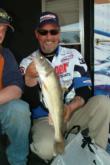The river walleye
Early season ’eyes in moving water

When ice floes quit ripping with the onset of spring, the time is prime to take it to the river. The water’s running, the season’s open, and saugers and walleyes are chomping.
This is why the Wal-Mart FLW Walleye Tour started its season twice on the sauger-thronged Illinois River and is now returning April 5 to the Detroit River – the 32-mile-long chute between lakes St. Clair and Erie, where nearly 1 million walleyes ascend with vernal predictability.
The patterns to catch them share remarkable similarities with other big rivers in walleye and sauger country because of water temperature, clarity and current. Wherever you go, be it the Illinois, Mississippi or Detroit, there’s a split decision to be weighed: covering vs. hovering. That is, covering water with trolling techniques, searching for active fish and provoking strikes with artificials, or hovering among them while jigging with bait, plastics or a combination thereof.
“In tournaments, someone in the top 10 always has a trolling bite going,” said pro Mark Courts of Harris, Minn. “We force them to eat.”
It’s no different on the Detroit, save for certain trolling specifics on a Great Lakes thoroughfare where the current speeds to 7 mph. While trolling shad-style crankbaits on leadcore line is a more typical M.O. on rivers with lesser flow – say, burning upstream at 2 mph against current running at a similar pace in the opposite direction – big weights and small baits unite given the intense flow. The reason? It takes a lot of lead to get to the bottom, where walleyes hold in deep channels behind small rock piles or in roly-polies in the underwater terrain that afford current breaks.
Enter handlining, a decades-old Detroit River method that takes wire line, without rods, and weights of a pound or so to get to bottom. The setup delivers floating minnow baits, such as Original Rapalas, on heavy monofilament or fluorocarbon leaders to Davy Jones’ locker. Something similar can be accomplished with 50-pound braided line on muskie rods with 8- to 12-ounce weights, when motoring upstream with a gas auxiliary motor. If anything, the trolling techniques with what are essentially magnum three-way rigs get a lure to the fish zone and keep it there when creeping upstream or holding in heavy current, hovering the bait in the fish’s face and inspiring strikes when muddy water lowers visibility to inches.
 “I try to determine whether trolling or jigging is going to be more productive,” said FLW Walleye Tour pro Todd Riley of Amery, Wis. “In a river system like the Detroit, you’re actually covering more water when jigging than you would trolling.”
“I try to determine whether trolling or jigging is going to be more productive,” said FLW Walleye Tour pro Todd Riley of Amery, Wis. “In a river system like the Detroit, you’re actually covering more water when jigging than you would trolling.”
Indeed, the brisk current whisks a boat downstream at breakneck speed when jigging compared to the covering-and-hovering approach of the big weights and tiny minnow baits (most often sizes 7, 9 and 11). Even so, the subtlety of vertical jigging often trips the trigger of big river fish, particularly in water clarity that affords visibility of the big motor’s propeller. Jigging is also a way to fish among a crowd; a common occurrence in the Detroit’s urban setting, as opposed to trying to troll upstream against a jigging armada.
Undoubtedly, jigging with bait and scented soft plastics makes intuitive sense when water temperatures are in the low 40-degree range, even though trolling with hard baits nevertheless excels. What jigging allows is precise placement of a minnow or Berkley PowerBait offering within a few inches of the bottom. When you drift over gnarly rock piles that infest the Detroit, you drop the jig behind them, where walleyes hold out of the current. Vertical jigging is just that – a line rigged on a 6-foot spinning rod with a jig straight below the boat, not on a snag-grabbing angle, to stay a touch above rocks and rebar. Touch bottom, lift up and hover the jig 4 to 6 inches from bottom, where walleyes have but a moment to decide whether or not to open wide. Drift through the fish, reel up, motor upstream and do it all over again.
The principles of jigging vs. trolling are not solely for the Motown madness of the spring walleye invasion. Let them eat bait – even the artificial variety – depending on water clarity and current. In other words, get on the Illinois, Mississippi or Detroit, and go with the flow when saugers and walleyes are chomping in cold water at the season’s start.